Handmade knives from the Florida maker see action over the skies of the European Theater of World War II.
Editor’s note: This year marks the 80th anniversary of D-Day, the Battle of the Bulge and other pivotal events of World War II. The Green Bats of the 422nd Night Fighter Squadron flew fighter support for Allied troops after D-Day and played a crucial role doing the same during the Battle of the Bulge. They also loved their Randall knives. This is the story of some of those men and their Randalls.
The Green Bats of the 422nd Night Fighter Squadron carried Randall knives into battle from Normandy through V-E Day, in the process achieving more aerial victories than any other American night fighter squadron during World War II.
Founded by BLADE Magazine Cutlery Hall-of-Fame® member W. D. “Bo” Randall in Orlando, Florida, in 1938, Randall Made Knives gained prominence after the United States entered the Second World War, as many American servicemen carried Randall knives into battle.
A newspaper story from November 1942 highlighted the growing number of Randalls carried by members of the U.S. military, including Frank O. Hunter, who commanded the 23rd Composite Group of the U.S. Army Air Corps at Orlando Air Base in 1941. Many airmen based in Orlando over the following few years also bought Randalls, including the Green Bats of the 422nd Night Fighter Squadron (NFS).
Need For Night Fighters
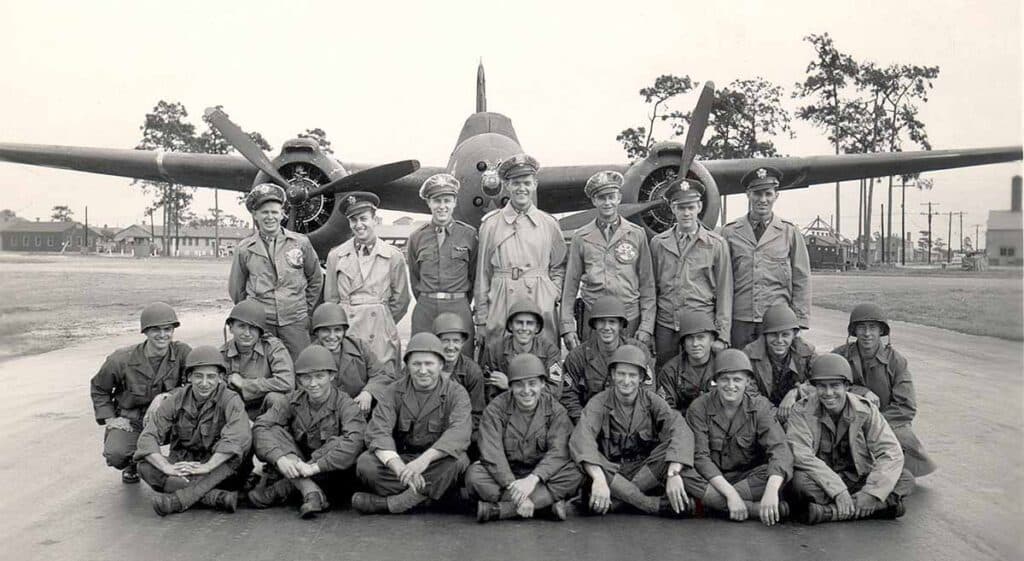
During the first two years of the conflict, the United States transitioned its economy to a war footing and began to develop the new fighting capabilities it would need to combat the Axis powers. Among many priorities was the pressing need for American airmen to develop a night fighting capability.
From the experience of the Royal Air Force during the Battle of Britain, American observers concluded that effective interception of enemy aircraft in night operations would require an entirely new aircraft that was designed to carry the most advanced airborne radar then available. It was further recognized that night fighter aircrews would require special qualifications and training that emphasized instrument flying, blind landings, night gunnery, and other expertise that was scarce in the Air Corps at the beginning of the war.
The new aircraft was the P-61 Black Widow, a high-performance, stable, twin-engine plane with heavy armament and the SCR-720 airborne radar. The Black Widow’s original design called for a crew of three—pilot, radar operator and gunner—but the planes of the 422nd NFS flew with only a pilot and a radar operator. As the first Black Widows rolled off the assembly line in the autumn of 1943, the rigorously selected NFS aircrews obtained their specialized training at Orlando Air Base and two nearby airfields in Kissimmee and Dunnellon.
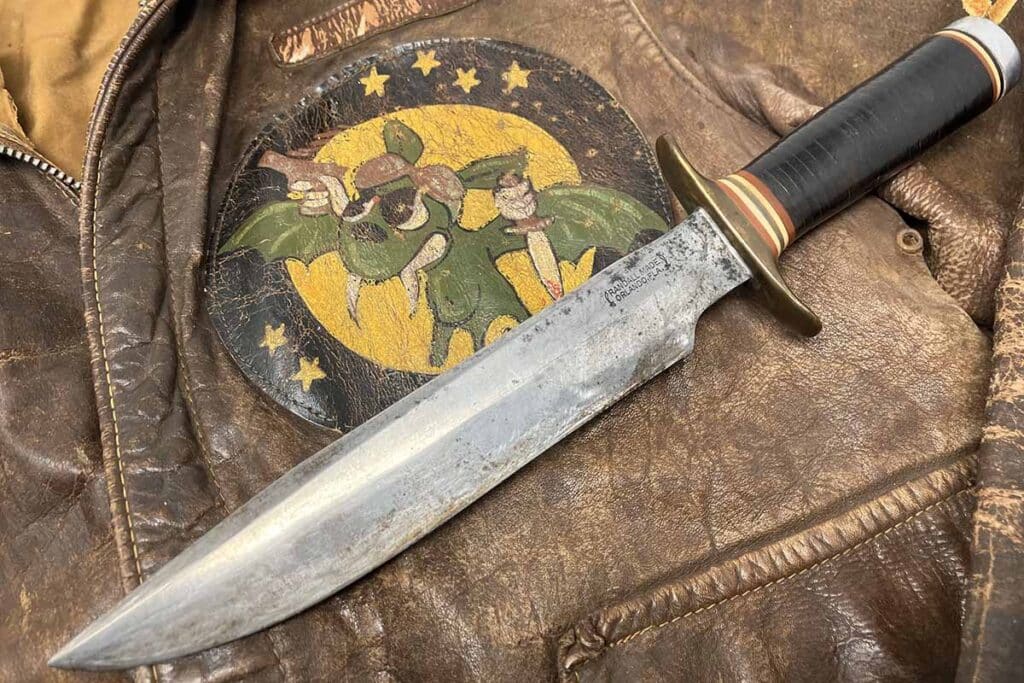
The first squadron to complete training with the Black Widow and fly it into battle was the 422nd NFS. The 422nd was activated in Orlando on Aug. 1, 1943, but squadron members did not receive their first Black Widows until Nov. 20, 1943. While eagerly awaiting their planes, squadron members devoted considerable time to organizational duties and field training, and many of the officers and men qualified with pistol and carbine.
3 Model 1s
During this time, many pilots and radar operators of the 422nd also obtained Randall knives. Among the known surviving Randalls of the 422nd are three Model 1’s that belonged to radar operators Louis L. Bost and James W. Mogan, and pilot Lewis Albert “Al” Gordon. The knives were ordered in the latter months of 1943, perhaps into early 1944, while the squadron was training in the vicinity of the Randall shop.
Gary Clinton, an authorized dealer for Randall Made Knives and noted Randall collector, stated that “Every Randall is one-of-a-kind, since they are all handmade.” This is especially true for the Randalls of World War II, which was a time of experimentation and development. Randall Made Knives had a hard time acquiring some of the necessary materials to make the knives because of wartime constraints. As a result, there are many variations in Randalls from World War II, and you see can see some of the variations in the NFS group.

The monel wrist thong link on James Mogan’s knife is an example. Leather washers of different thickness in the handles, the shapes of the handle, and other variations are also products of material availability and evolution of design.
Chris Stanaback, an authorized dealer for Randall Made Knives and founder of the Randall Knife Collectors Club, agreed that the three Randalls are “prime examples of World War II fighters” and also noted that the left-side carry sheaths are typical of the vintage. Clinton concluded, “World War II Randall knives are rare in their own right, but the provenance associated with these knives is extremely rare. It is almost unheard of to have such a fine collection that can be attributed to a small group of airmen from this era.”
First Victories
With Randall knives in hand, the 422nd NFS departed Orlando in mid-February 1944 and arrived in the United Kingdom in early March 1944. After a frustrating wait for their Black Widows, members of the 422nd entered combat on July 3, 1944, when squadron commanding officer Oris B. Johnson flew the first P-61 combat mission in the European theater.
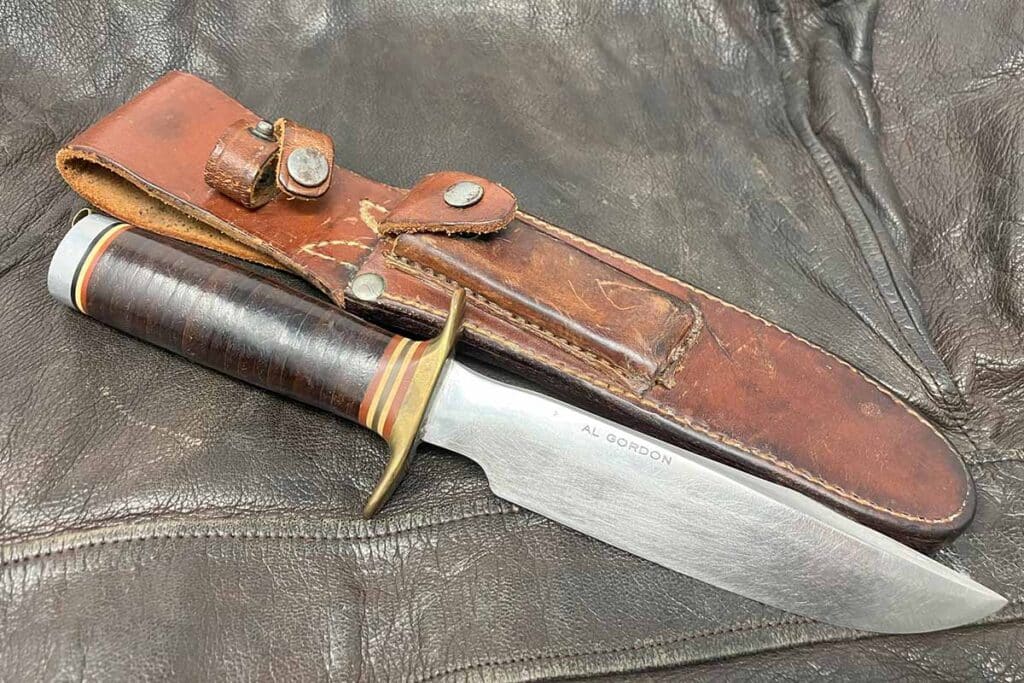
The squadron’s first victories came against Germany’s V-1 “Buzz Bomb,” an early jet-powered cruise missile initially used against London in June 1944. Because the Black Widow in level flight could not match the 400-mph speed of the V-1, P-61 pilots on night patrol had to locate the Buzz Bombs and then attack them in a power dive. Though this was no easy initiation to combat, the aircrews of the 422nd were up to the task, destroying five Buzz Bombs in late July, including one by Lt. Mogan and his pilot, Lt. John W. Anderson*. By early August 1944, the squadron had relocated to Cherbourg, France, defending the Allied forces in Normandy fighting to liberate Europe.
Soon after beginning combat against the pilots of the German Luftwaffe in Normandy, the 422nd achieved the first American victory with the Black Widow in Europe. There were three enemy planes confirmed destroyed, four probably destroyed, and one possibly destroyed in August 1944.
These included one confirmed destroyed by Lt. Bost and his pilot, Lt. Leonard F. Koehler, and one probable and one possible by Lt. Gordon and his radar operator, Lt. Creel Morrison. By the end of the war in Europe, the squadron had attained a remarkable combat record, with 1,480 sorties, 78 enemy aircraft sighted and 43 confirmed victories—plus five probables and five possibles—destroying more than half the enemy planes they encountered.
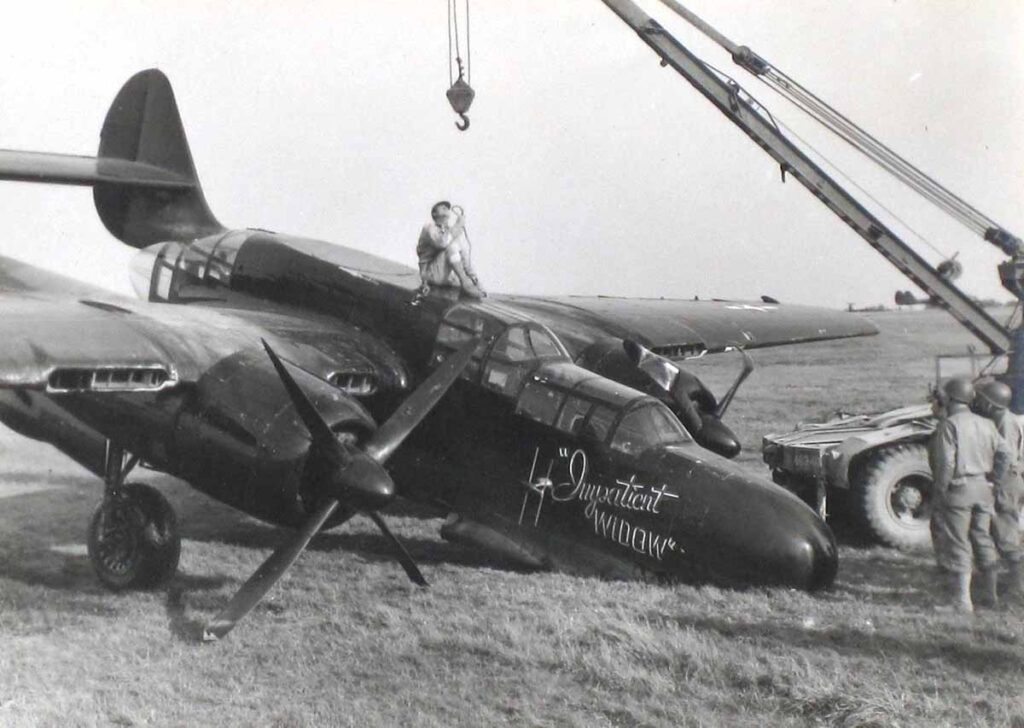
In addition, the squadron excelled in ground attack missions, which were essential to prevent enemy troop and supply movements at night. In the process they destroyed or damaged nearly 1,000 locomotives, railroad cars and motorized transports, along with many factories and storage sites. The 422nd was the first American night fighter squadron to produce an ace pilot, and six of the nine total American night fighter aces were in the 422nd.
The Bulge
Perhaps the squadron’s finest hour was the Battle of the Bulge, when the Germans launched a fierce counter-offensive during the harsh winter of December 1944.
At night and in extremely adverse weather, the Black Widows at times were the only planes able to fly in support of the 101st Airborne during the siege of Bastogne, and their performance was simply magnificent. The 422nd shot down five enemy planes on the night of December 16-17 and again on December 26-27.
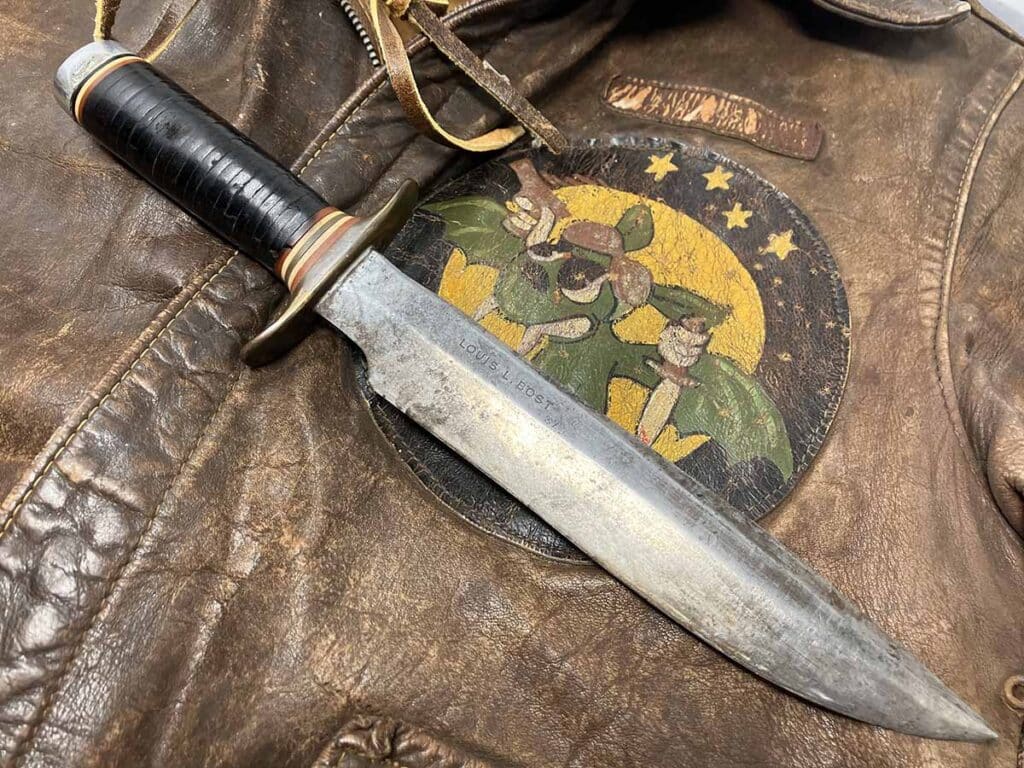
The squadron achieved a total of 18 confirmed victories in December 1944, compared to 10 total in the preceding four months. Stars and Stripes reporter Pat Mitchell accompanied Lt. Mogan and his pilot on a Christmas Eve patrol, and Mitchell’s front-page story described in dramatic detail the Black Widow’s victory over the German plane after a pinwheeling, 20-minute dogfight from 5,000 feet down to 500 feet.
Mogan and Anderson received the Distinguished Flying Cross for their courage, skill and determination during the Ardennes offensive. Bost and Gordon also received Distinguished Flying Crosses for valor and skill in aerial combat over Europe. The commanding general of the 101st Airborne Division gratefully acknowledged the squadron for their air protection during the Battle of the Bulge, noting that they repeatedly broke up German night fighter attacks on his troops and prevented the Germans from moving under cover of darkness.
A subsequent report on the battle showed that the 18 victories of the 422nd nearly matched the combined total of 20 achieved by six squadrons of Royal Air Force night fighters that December—truly remarkable considering that the RAF fielded 10 times as many operational aircraft, and that the 422nd had only four operational planes for much of the battle. In recognition of their heroism and pioneering efforts in night air combat, the 422nd was awarded the Distinguished Unit Citation (later renamed the Presidential Unit Citation) and the Fourragère of the Belgian Croix de Guerre.

Bost, Gordon, Mogan and the others in the 422nd Night Fighter Squadron deserve recognition for their essential contributions to the Allied victory in Europe, and the association between Randall knives and American military men such as these is an important part of the enduring legacy of Bo Randall and his finely crafted blades.
Sources: Queen of the Midnight Skies, by Garry B. Pape and Ronald C. Harrison; Conquering the Night, by Stephen Lee McFarland; Into the Night, by John W. Anderson and Martyne Anderson Kostka; 422nd Night Fighter Squadron: A History, by Charles McEwen, Jr.; “Black Widow Prowls Front, Stings JU88 in Sky Duel,” by Pat Mitchell, Stars and Stripes, Dec. 26, 1944; and Randall Made Knives: The History of the Man and the Blades, by Robert L. Gaddis
*Lt. John W. Anderson is the same Lt. John W. Anderson who supplied the vintage World War II images for this story.
More On Military Knives:
- MILITARY KNIVES: SOLDIERS’ EDC FROM THE PAST 50 YEARS
- U.S. MADE MILITARY KNIVES AND MAKERS
- FOUR BATTLE TOUGH MILITARY-STYLE FIXED BLADE KNIVES
- WHAT U.S. MILITARY MEMBERS LOOK FOR IN A KNIFE







